
Huntsman spiders, members of the family Sparassidae, are known by this name because of their speed and mode of hunting. They are also called giant crab spiders because of their size and appearance. Larger species sometimes are referred to as wood spiders, because of their preference for woody places. In southern Africa the genus Palystes are known as rain spiders or lizard-eating spiders. Commonly, they are confused with baboon spiders from the Mygalomorphae infraorder, which are not closely related.

The Pholcidae are a family of araneomorph spiders. The family contains more than 1,800 individual species of pholcids, including those commonly known as cellar spider, daddy long-legs spider, carpenter spider, daddy long-legger, vibrating spider, gyrating spider, long daddy, and skull spider. The family, first described by Carl Ludwig Koch in 1850, is divided into 94 genera.
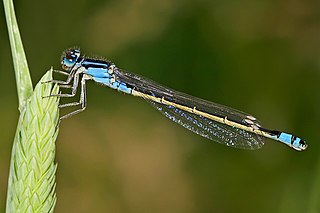
Ischnura is a genus of damselflies known as forktails in the family Coenagrionidae. Forktails are distributed worldwide, including various oceanic islands. The males have a forked projection at the tip of the abdomen which gives the group their common name.

Prunus ramburii is a species of plant in the family Rosaceae. It is endemic to Spain. It is threatened by habitat loss.

Rambur's forktail is a member of the damselfly family Coenagrionidae. Males are green with blue on abdominal segments 8 and 9. Females are orange-red, olive green, or similar to males in coloration. This is the most widespread New World Ischnura, occurring throughout the Americas from the United States to Chile, as well as Hawaii and the Antilles.

Trogoderma variabile, the warehouse beetle, is a species of carpet beetle in the family Dermestidae. It is found in Europe, Asia, Central America, North America and Oceania.
Atomaria fuscata is a species of silken fungus beetle in the family Cryptophagidae. It is found in Europe and Northern Asia, North America, and Southern Asia.

Gnathoncus rotundatus is a species of clown beetle in the family Histeridae. It is found in Europe and Northern Asia, North America, South America, and Southern Asia.
Liposcelis entomophila is a species of booklouse in the family Liposcelididae. It is found in Africa, Australia, the Caribbean Sea, Europe and Northern Asia, Central America, North America, South America, and Southern Asia.
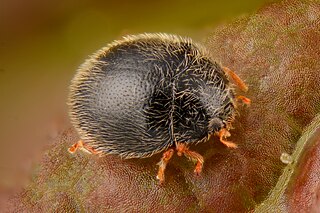
Stethorus punctillum, known generally as the lesser mite destroyer or spider mite destroyer, is a species of lady beetle in the family Coccinellidae. It is found in Africa, Europe and Northern Asia, Southern Asia, and North America.

Coccinella trifasciata, the three-banded lady beetle, is a species of lady beetle in the family Coccinellidae. It has a broad distribution, including North America, Europe, Northern Asia, Oceania, and Southern Asia.
Cercyon marinus is a species of water scavenger beetle in the family Hydrophilidae. It is found in Europe and Northern Asia, North America, and Southern Asia.
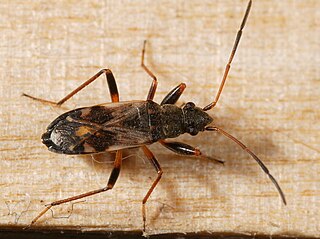
Ligyrocoris sylvestris is a species of dirt-colored seed bug in the family Rhyparochromidae. It is found in Africa, Europe and Northern Asia, North America, and Southern Asia.
Cercyon unipunctatus is a species of water scavenger beetle in the family Hydrophilidae. It is found in Europe and Northern Asia, North America, and Southern Asia.

Lepinotus inquilinus is a species of granary booklouse in the family Trogiidae. It is found in Africa, Australia, Europe and Northern Asia, Central America, North America, Oceania, and Southern Asia.

Soronia grisea is a species of sap-feeding beetle in the family Nitidulidae. It is found in Europe and Northern Asia, North America, and Southern Asia.
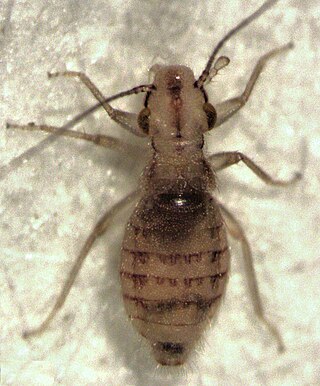
Trogium pulsatorium, known generally as larger pale booklouse, is a species of granary booklouse in the family Trogiidae. Other common names include the deathwatch, common booklouse, and grain psocid. It is found in Africa, Australia, Europe and Northern Asia, Central America, North America, Southern Asia, New Zealand, and Antarctica.
Psyllipsocus is a genus of cave barklice in the family Psyllipsocidae. There are more than 50 described species in Psyllipsocus.
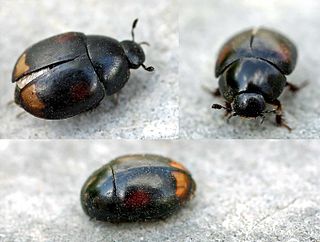
Sphaeridium scarabaeoides is a species of water scavenger beetle in the family Hydrophilidae. It is found in Africa, Europe and Northern Asia, North America, Oceania, and Southern Asia.
Callicrania is a genus of European bush crickets in the tribe Ephippigerini, first described by Ignacio Bolívar in 1898 as "Ephippigera (Callicrania)". To date (2022), species have only been recorded from the Iberian peninsula.














